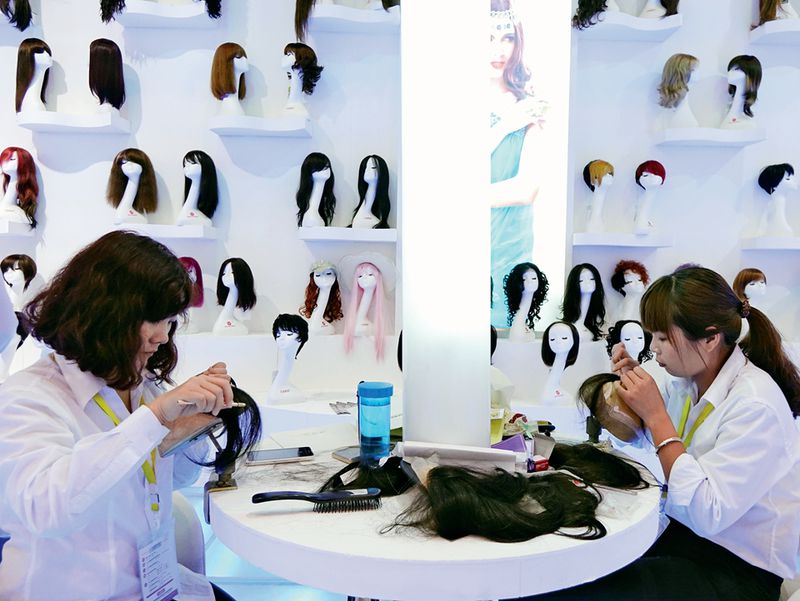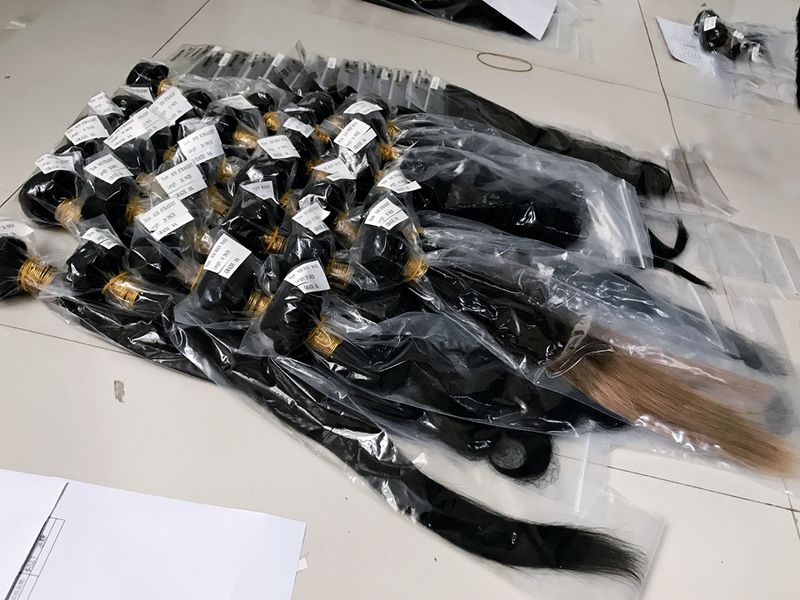The growing pains of China’s unique wig industry
It was the hairiest murder in Chinese history: The Duke of Wei is said to have died over a wig in 478 BCE.
According to The Commentary of Zuo, the Duke admired the beautiful hair of the wife of a Mr. Ji so much that he commanded his men to cut it off to make a wig for his own wife, Lü Jiang. Later, when he happened to seek refuge in Ji’s home from invaders, Ji promptly slew him in revenge.
While it’s no longer a matter of life or death, hair remains a serious business for China. As the exporter of 70 to 80 percent of the world’s wigs, it has benefited from a long history and expertise in hair sourcing and treatment, weaving together a global network of raw hair suppliers, processing workers, and consumers stretching from Southeast Asia to Africa.
Now also facing rising domestic demand due to hair loss among millennials, as well as cosplay hobbyists, the niche industry is seeing increased acceptance at home—while also becoming more vulnerable to global issues such as the shortage of raw materials and labor, quality and ethical sourcing complaints, trade wars, and disruptions due to the Covid-19 pandemic.
Around 50 percent of hair products around the globe come from Xuchang, a city of 400,000 in central Henan province that claims to have over 100 years of history of exporting hair. False hairpieces are recorded to have been worn for religious rituals and fashion in China for at least 3,000 years, and shops specializing in making and selling wigs emerged in the Song dynasty (960 – 1279).

Wig-making is a labor-intensive task usually taking 35 to 50 days
However, Xuchang’s hair business began in the Qing dynasty (1616 – 1911), when locals of the impoverished region began selling their locks to make wigs for opera performers. In 1900, a German hair trader opened a business in Xuchang’s Quandian village that purchased hair from locals, combed and dressed them, and sold them as wigs abroad. Local records stated that by 1933, the hair-trading volume in Xuchang reached millions of yuan.
The business was disrupted by war and political turmoil in subsequent decades, but family-run hair-processing workshops sprung up again in the 1980s and began producing their own brands. By 1989, the city already boasted 45 hair-processing factories and 675 independent workshops, exporting 400 million USD’s worth of hair per year.
The following year, local entrepreneur Zheng Youquan consolidated several workshops to set up the enterprise that later became Rebecca Hair Products, now the world’s largest wigmaker, which sells its products to 40 countries and regions. A local official told the Beijing News last April that over 300,000 people in Xuchang are engaged in the wig industry, producing over half of all of China’s hair exports—over 3,000 varieties of weaves, bundled hair, wigs, toupees, hair pieces, and other human and synthetic hair products.
According to Wang Wei, general manager of a wig company in Hebei province, China’s advantage in the global hair industry is a natural one. “Out of the best quality untreated hair, hair from East Asians is preferred, mainly from Chinese and Koreans, followed by Vietnamese and Indian hair,” Wang tells TWOC, explaining that East Asian hair is usually straight, and highly adaptable for bleaching and dyeing. A report by Xinhua News Agency in 2017 referred to long, untreated Chinese hair as “black gold” in the industry.

Wigmakers demonstrate their work at a hair exposition in Zhengzhou, Henan
In ancient China, hair-cutting was regarded as taboo. “Body, hair, and skin are given by one’s parents; it is a first requirement of filial piety to keep them undamaged,” instructs the Confucian Classic of Filial Piety. Under the Manchu rulers of the Qing dynasty, Chinese men were also forbidden from cutting their long queues. Among women in many rural areas, the habit of keeping long locks persisted into the present day.
Zeng Xiu, a woman in her 50s from a remote village in Hengyang, Hunan province, says she sold her waist-length hair for over 100 RMB 20 years ago. “At that time, selling hair on the street was common at the market in our town. I was patted on the shoulder and asked about my hair a dozen times each time I went there,” she recalls.
Zeng tells TWOC that she and her daughter have sold their hair several times, usually waiting several years in between each time for it to grow back. Back then, their hair likely ended up in North America and Europe—Rebecca was even listed on the Shanghai Stock Exchange in 2003, mainly on the strength of its US exports—with little chance of being sold in wigs at home.
“Those of us in the industry agree that the domestic false hair market changed in the year 2000,” says Wang, who started out by helping with his father’s wig business in northeastern China in the 1990s. “In the 90s, one hairpiece retailed for 3,000 to 4,000 yuan, and there were few buyers in China, mostly high-income individuals.”
Domestic consumers were also adverse to the idea of false hair. In one thread on question-and-answer platform Zhihu, a manufacturer in Xuchang reassures users who are still concerned that wigs are made from the hair of dead people, and are unhygienic or unlucky. “Before 2000, no matter if the wig was made from real human hair or not, Chinese people felt it was fake and were very resistant to it,” says Wang.

Natural hair must be carefully cleaned of keratin, combed, and crocheted into wigs
But these trends are beginning to reverse themselves. Rebecca’s wig sales on the “Single’s Day” shopping festival on November 11, 2019, totaled over 5.96 million RMB domestically. “Now that we have more advanced skills and can make our wigs more real, the public has become more accepting of it,” Wang tells TWOC.
The mushrooming domestic demand is linked to increased hair-loss among more appearance conscious and internet savvy young Chinese. According to a report by mobile-internet consultancy iiMedia Research last August, over 250 million Chinese, or one in six, suffered from hair loss, or alopecia. Around 60 percent of them developed the problem before the age of 25, a trend attributed to stress and unhealthy living habits among the young.
In 2017, a health information company, which had attracted investment from e-commerce giant Alibaba, reported that consumers born in the 1980s and 90s were responsible for around 75 percent of purchases of hair-loss products on e-commerce sites Tmall and Taobao, with those born after 1990 comprising 36 percent of wig buyers.
A 24-year-old postgraduate student in Beijing, who wished to be identified by her surname, Li, tells TWOC she began wearing wigs at college five years ago. She had started to lose hair badly during high school, which she blamed on study pressure, and turned to wigs after various Chinese medicine and infrared therapies failed to produce an effect. “I participated in lots of campus activities, and cared very much about my looks,” she says.

Domestic wigmakers are putting on fashion shows and hiring brand ambassadors to promote their products at home
After rejecting the products at her local wig shops due to poor quality, she began to buy wigs on Taobao for 200 to 600 RMB apiece, though she remained skeptical of their authenticity. “Even though I got the wigs cut at a barbershop to look natural, they’d stick up when there was a gust of wind, so you could tell,” she says. “Sometimes, I felt that wearing a wig attracted even more stares than not wearing one.”
Quality is a hurdle that domestic wigmakers have long struggled to overcome. “On the global market, China wins on quantity,” says Wang. “The people of Xuchang were the first to think of mixing animal hair with human hair [in wigs]; a wig that uses 30 percent animal hair can lower its overhead costs by 20 percent.”
Lacking regulations, the Chinese wig industry is rife with price inflation and false advertising. “There are no trade organizations to validate that a wig is made from human hair, and no regulations. As long as you register a business, you can start making and selling [wigs],” claims Wang. He recounts stories of a sick relative who spent 7,000 RMB on a wig that Wang knew had cost only 200 RMB to make, and of vendors who convince balding customers to shave their head so that they can sell more wigs.
Meanwhile, as incomes rise and fashions change, long, untreated hair is growing harder to find within China, and people are no longer as desperate to sell. Wig companies have coped by sourcing hair from other countries, such as India, Myanmar, and Vietnam, making them vulnerable to disruptions in global trade.

Rebecca now operates high-end wig retail stores across China
During the worst of the Covid-19 pandemic in early 2020, when import channels for raw hair from South and Southeast Asia were shut down, the price for a one-kilogram bunch of untreated Chinese hair 60 centimeters in length reached 3,000 RMB, up 20 percent from before the pandemic, and triple the usual price for Southeast Asians’ hair, according to People magazine.
The industry is also facing a domestic labor shortage, especially from young workers. In its heyday, there were said to be over 20,000 Xuchang residents travelling around China and Southeast Asia to collect hair from villages or hair salons or collectors, and process them back in Xuchang.
Now, according to the Beijing News, the proportion of households engaged in the wig business in one village in Xuchang has fallen from 80 percent to 50 percent, and over 90 percent of workers are women older than 40.
Suppliers have begun sourcing hair from villages in Cambodia, India, and Vietnam, and some have also established factories overseas due to the lower cost of labor and raw materials, as well as to avoid a 2017 directive by the Chinese government banning the import of unprocessed human and animal hair.
Wang estimates that 80 to 90 percent of high-end Chinese-made wigs are knitted in North Korea, where his own company employs 400 contract workers due to lower labor costs. They are then sent back to China to be combed and styled. However, most of these orders were delayed when North Korea closed its borders at the start of the Covid-19 pandemic, while many finished products were stuck in China when distributors were met with travel restrictions in their destination markets.

A customer gets fitted for a wig at a roadside shop in Guangzhou
Overseas wig-wearers remain important to the industry. Due to mounting import tariffs from the US on Chinese goods, Africa has become Rebecca’s largest market. According to the company’s 2018 annual report, its turnover on the continent totaled 895 million RMB, just under 50 percent of its total exports. The volume of hair product transactions in Africa on global retail platform AliExpress is increasing annually by 100 to 300 percent.
Domestically, a new segment of consumers is now rising to create demand for wigs: cosplayers like Xiaohui (pseudonym), an 18-year-old college freshman in Jinan, Shandong province. Over three years ago, Xiaohui bought her first wig with the matching costume to cosplay Krul Tepes, a character from Japanese cartoon Seraph of the End, at an anime convention. Now she owns dozens of wigs, priced at around 100 RMB each, and wears some in daily life from time to time.
Xiaohui tells TWOC that it’s a common practice in the “2D” community, or fans of Japanese animation. “The wigs enable us to try different hairstyles in various colors without hurting our own hair with the perms and dyeing,” she explains.
Wang also noticed a spike in young Chinese wearing wigs as fashion accessories in 2009 and 2010, which coincided with Rebecca’s efforts to expand the domestic market in 2009. The company hired as its brand ambassador Fan Bingbing, a Chinese actress and global fashion icon who has worn wigs in various red carpet appearances.
Li, however, stopped wearing wigs three years ago on a doctor’s advice, due to concerns that it could clog her pores and worsen her hair loss. She tells TWOC she now lives in peace with her baldness, but dreams of a future where “smart wigs” can automatically tailor their shape to the individual wearer.
That prospect may still be in the realm of science fiction, but Wang agrees that innovation is key to the survival of China’s wig industry. “China’s status as the ‘world’s factory’ may be replaced by India or Vietnam, so we need to improve our craftsmanship, and make our products sharper and more exquisite,” he muses. “How that’s going to happen, I don’t know. It may be a slow process, not something you can do in a day.”
All images from VCG
A Tangled Weave is a story from our issue, “Rural Rising.” To read the entire issue, become a subscriber and receive the full magazine.












